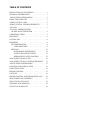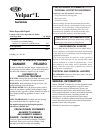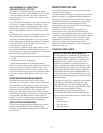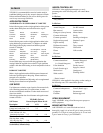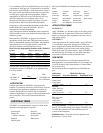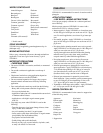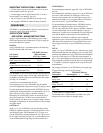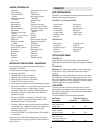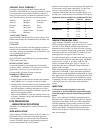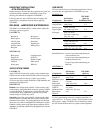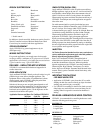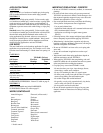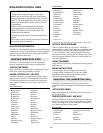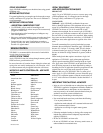
WEEDS CONTROLLED
* Partial control
IMPORTANT PRECAUTIONS - SUGARCANE
Do not plant any crop other than sugarcane following an
application of VELPAR L.
Do not feed sugarcane forage to livestock.
Do not apply VELPAR L:
• Within 180 days of harvest in Hawaii.
• Within 234 days of harvest in Louisiana.
• Within 288 days of harvest in Puerto Rico.
• Within 234 days of harvest in Texas.
To avoid injury to sugarcane, observe the following precautions:
• Do not use VELPAR L on cane that shows poor vigor because
of insect damage, disease, or winter injury, or shows
symptoms of other stress conditions such as drought stress.
• Do not add a surfactant in applications unless otherwise
specified or allowed.
• Do not use VELPAR L on gravelly or rocky soils, thinly
covered subsoils, or coarse-textured soils (sands to sandy
loams) with less than 1% organic matter.
• Temporary chlorosis of the crop may result from application
over emerged cane. Applications during active cane growth
should be directed to cover the weeds and soil while
minimizing crop contact.
• Do not use VELPAR L on varieties known to be susceptible
to weed killers.
Extremely heavy rainfall after application may result in poor
weed control and/or crop injury, especially if the application is
made to dry soil.
SITE PREPARATION
VELPAR L is recommended for weed and brush control in areas
where the following species are grown:
EASTERN US AND LAKE STATES
WESTERN US
APPLICATION TIMING
EASTERN US
Apply VELPAR L from early spring to early summer after
hardwoods have broken bud and before the foliage has hardened
off.
WESTERN US
Rainbelt (areas of high spring rainfall): For best results, apply
in late winter or spring when weeds and brush are actively
growing.
Snowbelt (areas of low spring rainfall): For best results, apply
in the fall before soil freezes, or in the spring after snow cover
melts in anticipation of rainfall. Weed and brush control results
from spring applications will be dependent on sufficient rainfall
following application to activate VELPAR L.
USE RATES
Use the lower rates on coarse-textured soils and soils low in
organic matter; use the higher rates on fine-textured soils and on
soils high in organic matter. Use the higher rates where hard-to-
kill species predominate.
The rates listed below are for broadcast application.
Soil Texture VELPAR L (Qt/Acre)
Description Eastern US Western US
Coarse
Sand, loamy sand,
sandy loam 4–6 2–2.5
Medium
Loam, silt loam,
sandy clay loam 6–8 2.5–4
Fine
Silty clay loam,
clay loam, sandy clay,
silt, silty clay, clay 8–10 4–6
Blue spruce
Douglas fir
Engleman spruce
Grand fir
Jeffrey pine
Lodgepole pine
Noble fir
Ponderosa pine
Sitka spruce
White fir
Austrian pine
Balsam fir
Black spruce
Loblolly pine
Longleaf pine
Ponderosa pine
Red pine
Red spruce
Scotch pine
Shortleaf pine
Slash pine
Virginia pine
White spruce
FORESTRY
Ageratum*
Alexandergrass
Amaranth (slender,
smooth)
American burnweed
(fireweed)
Balsam apple
Barnyardgrass
Bermudagrass*
Carolina geranium
Chickweed
Crabgrass (hairy, large,
smooth)
Crotalaria (fuzzy, showy)
Cuphea (tarweed)
Dallisgrass
Fingergrass (radiate,
swollen)
Flora’s paintbrush
Foxtail (bristly, yellow)
Goosegrass
Guineagrass
Henbit
Itchgrass*
Jobs tears
Johnsongrass (from seed)
Jungle rice
Lambsquarter
Morningglory (hairy,
threelobe)
Mustard (wild)
Oxalis
Panicum (brownleaf,
browntop, Texas millet)
Paspalum (ricegrass, sour)
Pigweed (common,
smooth)
Popolo
Purslane
Sandbur
Sensitive plant (hila hila)
Signalgrass (broadleaf)
Sowthistle
Spanish needle
Sprangletop
Spurge (prostrate,
graceful)
Sunflower
Vaseygrass
Waltheria (hialoa)
8



